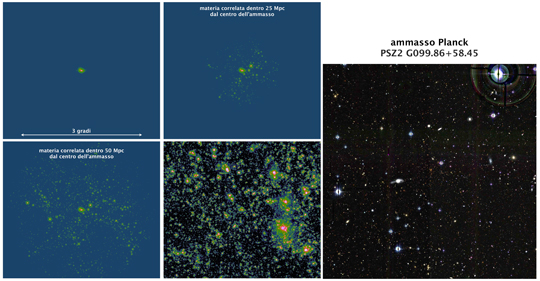 UNIBO-INAF-INFN. An international research group, including scientists from INFN, the National Institute of Astrophysics (INAF) and the University of Bologna, has succeeded in locating one of the densest cosmic clumps in the known universe. It is the cosmic environment around the galaxy cluster known as PSZ2 G099.86+58.45. The system has a density of matter around six times greater than the average of other observed clusters. The researchers measured the distribution of mass around the cluster up to a distance of 30 megaparsecs, in other words 6000 billion times the average distance between the Earth and the Sun. Studying this “cosmic web” is particularly complicated because there are fundamental components of the universe, dark matter and dark energy, whose properties we know nothing about. The researchers succeeded in detecting the high density of matter in the cluster because of an effect known as a “gravitational lens”, linked to the capacity of gravity to bend light and so create distortions in the image of celestial objects that we observe. So, in this case, the light generated by the galaxies that lie behind the cluster being studied is bent and amplified by its gravitational field. By analysing the shape of more than 150,000 galaxies, the research group managed to calculate the large concentration of matter around the cluster itself. A large number of numerical simulations led to interpreting the observational analysis of the formation of cosmic structures, which allowed us to quantify that less than 1% of galaxy clusters have such a dense cosmic web. The results of the study have been published in Nature Astronomy.
UNIBO-INAF-INFN. An international research group, including scientists from INFN, the National Institute of Astrophysics (INAF) and the University of Bologna, has succeeded in locating one of the densest cosmic clumps in the known universe. It is the cosmic environment around the galaxy cluster known as PSZ2 G099.86+58.45. The system has a density of matter around six times greater than the average of other observed clusters. The researchers measured the distribution of mass around the cluster up to a distance of 30 megaparsecs, in other words 6000 billion times the average distance between the Earth and the Sun. Studying this “cosmic web” is particularly complicated because there are fundamental components of the universe, dark matter and dark energy, whose properties we know nothing about. The researchers succeeded in detecting the high density of matter in the cluster because of an effect known as a “gravitational lens”, linked to the capacity of gravity to bend light and so create distortions in the image of celestial objects that we observe. So, in this case, the light generated by the galaxies that lie behind the cluster being studied is bent and amplified by its gravitational field. By analysing the shape of more than 150,000 galaxies, the research group managed to calculate the large concentration of matter around the cluster itself. A large number of numerical simulations led to interpreting the observational analysis of the formation of cosmic structures, which allowed us to quantify that less than 1% of galaxy clusters have such a dense cosmic web. The results of the study have been published in Nature Astronomy.
Immagine: Simulazione numerica della distribuzione di materia attorno a un ammasso su diverse scale.






